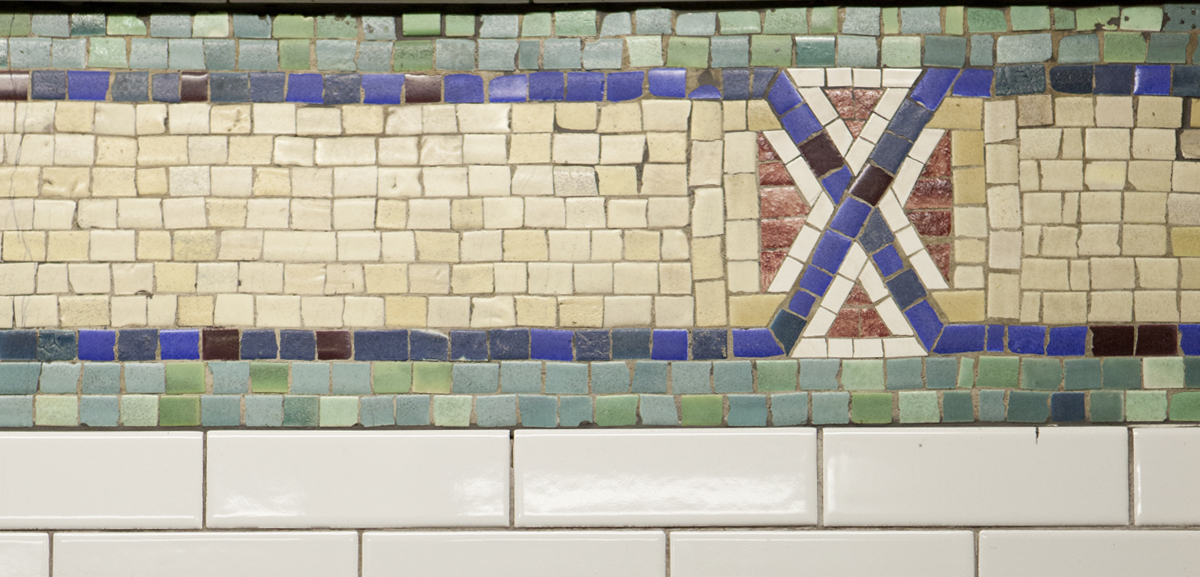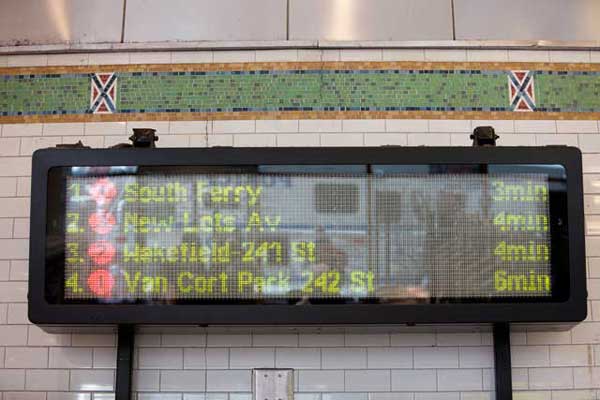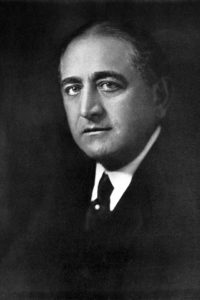In 2012, Civil War Times ran this article about small mosaics in the subway station beneath Times Square bearing an uncanny resemblance to the Confederate flag and the history behind their placement there.
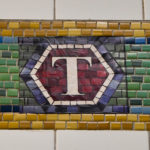
On a recent trip to NYC, a Civil War Times editor noticed they had been covered up with stickers of a less controversial design that were meant to mimic new tiling.
Although the New York Metropolitan Transportation Authority (MTA) had long contested that the mosaics appeared to be the Confederate battle flag, in August 2017, amid growing tensions surrounding Confederate monuments and symbols, the MTA announced it would modify the design, regardless. The MTA has not returned requests from Civil War Times for comment on the updated design.
[/box]
In New York City, on the walls of the sprawling subway station beneath Times Square, small mosaics bearing an uncanny resemblance to the Confederate battle flag form part of a decorative border. Can it be that the Southern Cross, an icon that still stirs controversy 150 years after the war, is prominently displayed at one of the world’s busiest intersections? According to the New York Metropolitan Transit Authority, the emblem—a blue X edged in white and set against a red background—stands for nothing more than the convergence of subway lines. But my research suggests a more interesting ancestry. Distinctive symbols are featured in stations throughout the system. For example, the Astor Place station is decorated with beavers, a reference to fur trader John Jacob Astor; the Grand Central Station has locomotives on its walls. So what can be inferred from the Times Square decor? ° Designed by architect Squire J. Vickers, the mosaic was installed in the station below the former New York Times building in 1917.
In a 1919 Architectural Record article Vickers, a somewhat eccentric figure, explained how designing with tile placed him in a position “conceived in strength and power, standing forth like a prophet of old, proclaiming calmly from a lofty height great and universal truths.” He recognized the power of symbols, and his mosaics were loaded with them, many speaking to New York’s history. ° Several notable Confederates are part of that past. Four Rebel generals are buried in the Bronx’s Woodlawn Cemetery, including Archibald Gracie III, whose home, Gracie Mansion, now serves as the official mayoral residence. Both Robert E. Lee and Stonewall Jackson lived in Brooklyn as young U.S. Army officers, and Stonewall was baptized in the city and spent his honeymoon there. Varina Howell Davis lived on Central Park West for the last 16 years of her life, working for the New York World.
Yet outside of calling New York home at some point in life—or death—those famous Rebels have no particular connection to Times Square. In fact, Times Square did not even exist prior to 1904; the neighborhood was then called Long Acre. For much of the 19th century, Long Acre Square was relatively undeveloped, known for its livery stables, grazing pastures and brothels. But in the early 20th century, the area between 7th Avenue and Broadway underwent a transformation, evolving into the “Crossroads of the World.” Rather than Lee or Jackson, a more likely candidate for the Times Square Confederate is perhaps the man who catalyzed that transformation. If the mosaic represents a convergence of subway lines, Vickers also unmistakably references the symbol of the South to highlight the station’s proximity to a publisher with strong ties to the South: New York Times owner Adolph S. Ochs.
In 1904 Ochs finished building his new headquarters at Long Acre Square, a skyscraper that would have its own subway station in its basement. To commemorate the new structure, the Board of Aldermen renamed the neighborhood Times Square. The Times building quickly became the cultural and artistic nucleus of Manhattan. Upscale hotels were built. New restaurants opened. And of course, there were the theaters. Times Square became the city’s meeting place, where New Yorkers came to grab a late edition, and where the world unofficially entered the New Year. By the time Vickers began building the subway station in 1917, Times Square was on the cusp of its legendary heyday in the Roaring ’20s. The Great White Way was born courtesy of Ochs and his “Old Gray Lady.”
The Confederacy was a significant part of Adolph Ochs’ family history, thanks to his mother. As a teenager in Bavaria, Bertha Levi Ochs was so outspoken in her sympathy for revolutionaries involved in the upheaval in 1848 that her family sent her to relatives in Mississippi. In America Bertha married Julius Ochs, also a German immigrant, and the couple soon moved to Ohio, where Adolph was born in 1858. When the Civil War broke out, Bertha decided that she couldn’t bear the Union’s despotism, and after her brother was commissioned a Rebel officer, she decided to go to Memphis. But her husband Julius remained loyal to the Union, and fought with an Ohio regiment.

This “house divided” stood just fine. Bertha helped the Confederates by smuggling spies and quinine across the lines. When she was caught, it was Julius, by that time a well-respected Union officer, who saved her from prison. In a 1930 speech at the Tomb of the Unknown Confederate Soldier at Mount Hope Cemetery, George Ochs, Adolph’s younger brother and the historian of the New York Chapter of the Sons of Confederate Veterans, spoke of his parents, saying the “beautiful bonds of affection and devotion to each other had happily withstood the crucial strain of civil strife, [and they] returned to their home in Tennessee, yet to the day of their death, the convictions of each remained unaltered, and both gave unflattering devotion to the respective causes, which each had so firmly upheld.” For Bertha this meant serving as a charter member of the United Daughters of the Confederacy. When she died, UDC members shrouded her coffin with the Confederate battle flag. In 1924 Adolph donated $1,000 to have his mother’s name engraved on the founders’ roll of the Stone Mountain Confederate Memorial. Enclosed with his check was a letter in which he summed up his mother’s views: “Robert E. Lee was her idol.”
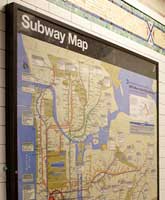
Although he spent the second half of his life in New York City, Adolph Ochs never forgot his Southern roots. Raised in Knoxville, Tenn., he had cut his teeth as a publisher of the Chattanooga Times, which he acquired when he was only 20 years old. It was not until 1896, following his purchase of the foundering New York Times, that he moved to New York. Years later, he would be honored by the New York Southern Society for a lifetime of “unusual achievements in the perpetuation of the history and traditions of the South” and for having “striven on the side of the angels for supporting with unique zeal and power the highest ideals and traditions of the Southern States.” He donated to establish Confederate cemeteries in Tennessee; to fund the United Confederate Veterans’ reunions; and to establish the Chickamauga & Chattanooga National Military Park. He ran editorials and commemorative and pictorial editions dedicated to Confederate veterans’ activities. But Ochs’ reverence for the South is best captured in his response to a 1927 controversy. Falsely accused by a Georgia newspaper of trying to thwart Stone Mountain from acquiring adjacent parkland, Ochs protested in an editorial citing his longstanding dedication to Dixie: “I concede to no newspaper publisher in the South a more loyal, sincere, enthusiastic and industrious advocacy of the best interests, welfare and prosperity of the South than I have shown in the Chattanooga Times and The New York Times. I am confident that all to whom I am known will attest that the South, its interests and its welfare have been and are part of my religion and profession and hobby.” When Ochs died in 1935, the UDC sent a pillow embroidered with the Confederate flag to be placed in his coffin.
In 1998, the Times Square subway station underwent a substantial renovation and expansion that included re-creations of Vickers’ mosaic tribute to Adolph Ochs. Even today, throughout the station’s cavernous, rumbling corridors, the Southern heritage of one of the city’s most influential figures is hiding in plain sight.
New Yorker Dr. David J. Jackowe, a lifelong student of the Civil War, writes about history, art, and medicine. This article was originally published in the August 2012 issue of Civil War Times magazine.

